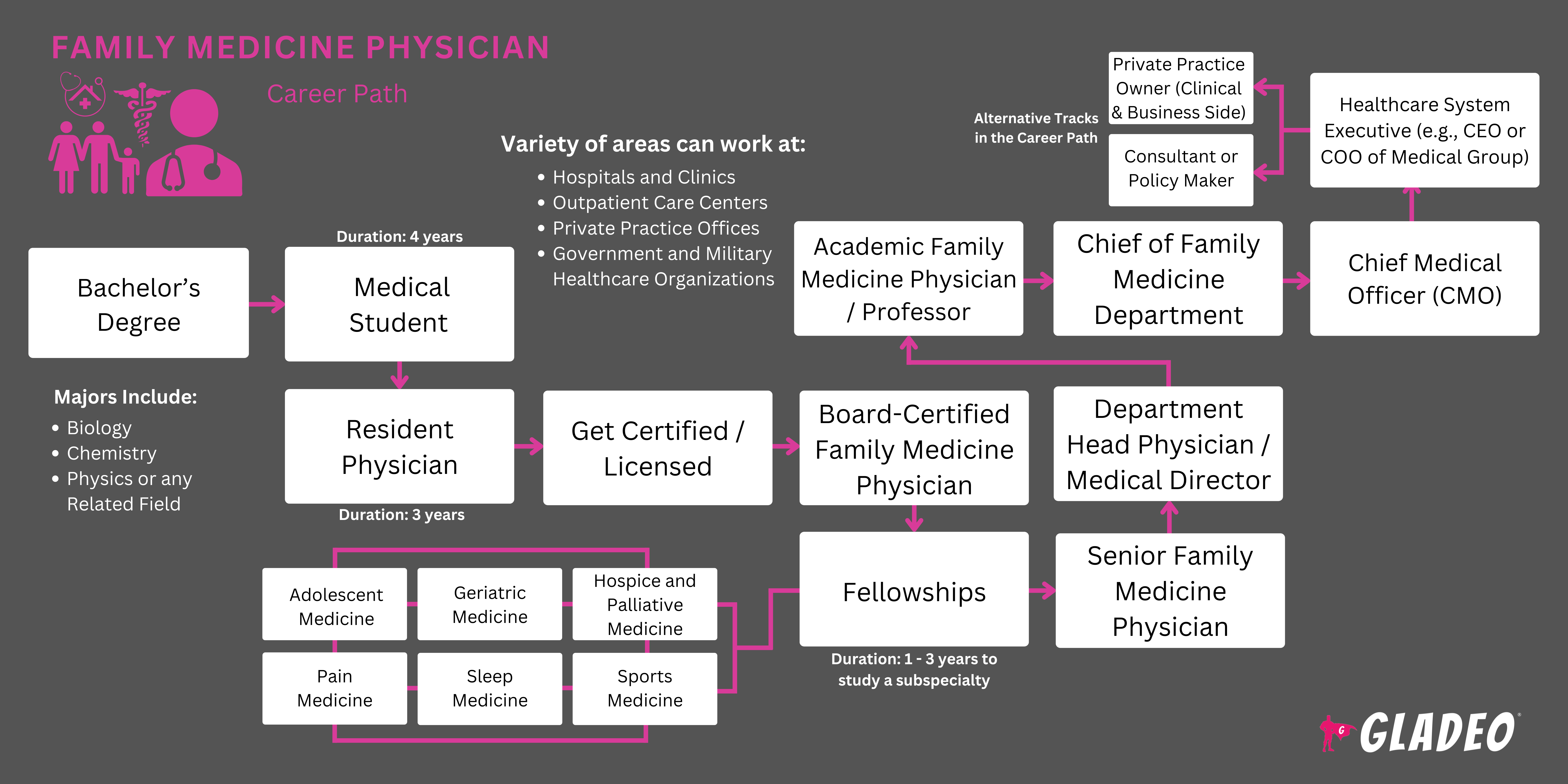Spotlights
Board Certified Family Physician, Family Medicine Physician, Family Physician, Family Practice Medical Doctor (FP MD), Family Practice Physician (FP Physician), Family Practitioner, Medical Doctor (MD), Medical Staff Physician, Physician, Primary Care Physician, General Practitioner (GP)
When we have a mild illness or injury, one of the first people we usually see is our Family Medicine Physician. Certified by the American Board of Family Medicine, these healthcare providers are trained to care for patients of all ages. They perform routine exams, assess patients’ medical signs and symptoms, and order screening tests such as blood work, X-rays, or CT scans. Based on their findings, they provide a diagnosis and treatment plan, prescribing medications as needed. They can also administer routine immunizations.
Family Medicine Physicians develop long-term relationships with their patients, seeing the same individuals for years. In fact, they often treat multiple members of the same family, hence the term “family medicine.” This continuity allows them to see patterns over time, anticipate potential issues, and offer tailored preventative care and treatment plans. They also conduct follow-ups to monitor the effectiveness of a medication or treatment.
In addition to providing primary care, Family Medicine Physicians can specialize in certain areas, too. However, when a patient’s condition requires further expertise, they refer them to advanced experts such as cardiologists, dermatologists, gastroenterologists, psychiatrists, physical therapists, surgeons, or others.
Note: Family Medicine providers are sometimes called General Practitioners (GPs), but this is no longer technically correct. In the US, Family Medicine Physicians undergo dedicated residency training, manage a wider range of conditions, and emphasize continuous and preventive care. In contrast, GPs often have less specialized training and may concentrate more on treating common or acute illnesses.
- Cải thiện sức khỏe, tuổi thọ và chất lượng cuộc sống của bệnh nhân
- Treating existing medical problems and helping to prevent new ones
- Mức lương và phúc lợi tuyệt vời với triển vọng việc làm dài hạn mạnh mẽ
- Nhiều cơ hội chuyên môn
Lịch làm việc
Family Medicine Physicians work full-time and often overtime, depending on employer requirements or work settings. They may be on-call to handle urgent patient needs, especially in hospitals and clinics. Many operate private practices and have numerous administrative and business tasks to perform on top of their medical duties.
Nhiệm vụ tiêu biểu
- Review patient notes and vital signs from physician’s assistant or nurse
- Listen to patient explanations of their symptoms and circumstances
- Ask questions to uncover additional information
- Review patient medical records and histories
- Perform routine or specific physical examinations, such as using a stethoscope to listen to heartbeats and breathing
- Order screening tests such as blood work and diagnostic imaging such as X-rays or CT scans
- Perform simple biopsies to take tissue samples for testing
- Input data and findings into medical software to update patient charts
- Consult digital medical reference materials
- Trả lời các câu hỏi của bệnh nhân và trả lời các mối quan tâm
- Review test results when available
- Make an initial diagnosis of any illness or injury when possible
- Provide or order direct treatment (such as setting a cast for a broken bone)
- Prescribe an at-home course of treatment. Write medication prescriptions
- Discuss treatment options and instructions with family members, as needed
- Offer tips for preventative healthcare and healthy lifestyles.
- Help at-risk patients understand how to avoid developing chronic conditions like diabetes or hypertension
- Refer patients to specialist providers, as needed
- Administer routine immunizations
- Order follow-up appointments to check out patient recovery
- Respond to acute or emergency cases, as circumstances warrant
- Assist with end-of-life care planning, advance directives, and palliative care options
Trách nhiệm bổ sung
- Perform routine health check-ups at least annually
- Conduct telemedicine visits and respond to patient messages via online portals, if used
- Keep up with newly-approved medicines, pharmaceutical
developments, treatments, and technologies - Work as part of a patient’s larger healthcare team to coordinate care
- Help train assistants and other team members
- Manage administrative duties or advertising campaigns related to one’s private practice
Family medicine is a specialty itself, but Family Medicine Physicians may choose a subspecialty such as:
- Y học vị thành niên
- Geriatric Medicine
- Hospice và Y học giảm nhẹ
- Obstetrics
- Preventive Medicine
- Sleep Medicine
- Sports Medicine
Kỹ năng mềm
- Cách thức bên giường bệnh
- Sự nhạy bén trong kinh doanh và kỹ năng tiếp thị (dành cho những người hành nghề tư nhân)
- Lòng thương
- Bình tĩnh
- Độ tin cậy
- Định hướng chi tiết
- Khéo léo
- Sự siêng năng
- Phối hợp tay-mắt
- Tính toàn vẹn
- Phương pháp
- Tinh ý
- Kiên nhẫn
- Giải quyết vấn đề
- Xây dựng mối quan hệ
- Ý thức an toàn
- Phán đoán đúng đắn
- Stamina
- Kỹ năng giao tiếp mạnh mẽ
- Giảng dạy
- Quản lý thời gian
Kỹ năng kỹ thuật
- Kiến thức sâu rộng về sinh học và sinh lý học của con người
- Kiến thức về các bệnh và chấn thương y tế, cũng như các dấu hiệu và triệu chứng của chúng
- Kiến thức về dụng cụ, thiết bị và phương pháp y tế
- Các kỹ năng chuyên môn liên quan đến lĩnh vực thực hành của một người
- Use of medical records software
- Làm quen với vai trò của các chuyên gia y tế khác
- Kiến thức về thiết bị bảo hộ cá nhân cộng với thực hành vệ sinh và khử trùng
- Bệnh viện và phòng khám
- Trung tâm chăm sóc ngoại trú
- Văn phòng hành nghề tư nhân
- Government and military healthcare organizations
Patients trust their Family Medicine Physicians with their health and well-being. In fact, many families have multiple family members seeing the same doctor. Thus, the job carries significant responsibilities, such as listening to patients carefully, dedicating sufficient time and attention to diagnose issues accurately, and maintaining high levels of competence and reliability.
Balancing these demands with personal life can be challenging. The ever-changing landscape of medicine requires doctors to engage in continuous learning to stay updated on the latest advancements. Those who operate their own private practices face the added pressure of managing business-related duties and costs, too.
For example, malpractice insurance is often a significant cost, running several thousand dollars per year. Doctors employed by hospitals or medical groups usually have their premiums paid, but those in private practice or smaller clinics typically shoulder this expense themselves. Private practice doctors must also pay for office rent, staffing, medical supplies, and electronic health record systems.
Family medicine is moving toward patient-centered, team-based models where care is coordinated among a multidisciplinary team. This comprehensive approach enhances the quality of care, improves patient outcomes, and optimizes resources, especially for those with chronic conditions.
As healthcare shifts to a value-based model, Family Medicine Physicians are pivotal in promoting wellness and preventing chronic diseases through patient education, screenings, early detection, and intervention. This model also incorporates lifestyle medicine, such as nutrition and mental health strategies, to address the root causes of illnesses.
The integration of technology such as telehealth is a growing trend, especially after social distancing and other restrictions implemented during the coronavirus pandemic. Beyond telemedicine, digital health tools like electronic health records, remote monitoring, and mobile apps are enhancing patient care and efficiency. AI and machine learning are also being used to assist with diagnosis and patient management.
Family Medicine Physicians may have had an aptitude for reading complex materials and been interested in biology and medicine from an early age. They could have also demonstrated compassion for others’ well-being.
Giáo dục cần thiết
- Family Medicine Physicians must complete extensive education and training requirements, starting with a bachelor’s degree and then working towards their Medical Doctor (MD) or a Doctor of Osteopathic Medicine (DO) at a medical school program.
- Bachelor degree majors vary, with popular pre-med majors including biology, chemistry, and biochemistry. These majors may help students to meet medical school prerequisites and to have a more competitive application.
Common undergrad courses may include anatomy and physiology, biochemistry, biology, biology labs, calculus, genetics, and organic chemistry.
Trường y tế
- Medical school programs consist of two main phases. The first “preclinical phase” features academic courses, labs, classroom activities, plus some practical skills development. The second “clinical phase” involves consulting with patients at clinics and hospitals under supervised conditions.
- Applicants must take and pass the Medical College Admission Test (MCAT) and submit results along with their program applications.
- The MCAT is a critical element of a successful application. The test is multiple-choice and designed to assess “problem-solving, critical thinking, and knowledge of natural, behavioral, and social science concepts and principles prerequisite to the study of medicine.”
- When assessing applications, med school review boards consider each applicant’s undergraduate coursework, GPA, and MCAT scores, as well as any demonstrated personality and leadership traits and extracurricular activities involvement. The review officers also conduct formal interviews of selected applicants.
- Note, a limited number of schools feature combined undergraduate and medical programs which can make the educational route smoother. These programs tend to be very competitive to get into.
Licensure and Residency
- After graduation from medical school, graduates must complete residency programs at a clinic or hospital, serving as “interns” for the first year. Residency programs help doctors develop deeper knowledge and hands-on experience in their specialty. Family medicine residencies may last ~3 years.
- Students can study to become either Medical Doctors (MDs) or Doctors of Osteopathic Medicine (DOs).
- Per Scripps.org, “More than half of DOs practice in primary care, specializing in internal medicine, family medicine and pediatric medicine where they can develop long-term relationships with their patients. DOs generally take a more holistic approach and look beyond the physical symptoms of illness or injury. They take into account the various aspects of a patient’s life — including body, emotions, the environment, mind and spirit — to develop an individualized care plan.”
- After the first year of residency, Family Medicine Physicians should apply for state licensure, with requirements differing from state to state.
- One common requirement is passing a national exam. MDs must pass steps 1 and 2 of the U.S. Medical Licensing Examination (USMLE). DOs must pass levels 1 and 2 of the Comprehensive Osteopathic Medical Licensing Examination (COMLEX-USA).
- In addition, doctors must complete either core clerkships or additional periods of clinical instruction.
Học bổng
- Family Medicine Physicians who choose a subspecialty must complete fellowship training which can take 1-3 more years. St. George’s University features an Ultimate List of Medical Specialties and Subspecialties to help understand the options. Family medicine subspecialties include:
- Y học vị thành niên
- Geriatric Medicine
- Hospice và Y học giảm nhẹ
- Obstetrics
- Preventive Medicine
- Sleep Medicine
- Sports Medicine
Board Certification
- Board certification is technically optional, but highly recommended because many employers and insurance companies require it. It also lets patients and peers know that the physician has met rigorous standards of education, training, and expertise.
- In addition, board certification can serve as a protective measure in malpractice cases.
- Certifying boards include the American Board of Family Medicine for MDs and the American Osteopathic Board of Family Physicians for DOs.
- Note, MDs must get recertified every 10 years. DOs must get recertified every 8 years.
- They must also fulfill Maintenance of Certification requirements, such as Continuing Medical Education, quality improvement activities, and periodic knowledge assessments or other evaluations as specified by the certifying board.
- Medical schools are tough to get into, so you need to be very well-prepared! That includes knocking out your bachelor’s in a relevant major while maintaining a strong GPA.
- Schools may post the minimum GPA requirements for applicants, but keep in mind that just meeting the minimum won’t make an application competitive.
- For undergraduate schools, look for programs that are accredited and feature the rigorous foundational coursework you’ll need to succeed at med school.
- Many schools serve as “feeder schools” for popular medical schools. It’s not required to attend a feeder school, but it could be helpful.
- Xem xét chi phí học phí (mức giá trong tiểu bang / ngoài tiểu bang), giảm giá, học bổng và các lựa chọn phân phối khóa học (trong khuôn viên trường, trực tuyến hoặc chương trình kết hợp).
- Review faculty bios and awards and learn what types of facilities and modern equipment the program utilizes. Also peek at the accomplishments of the alumni network!
- For medical school, check out the available options for clinical rotations, which are done at affiliated teaching hospitals, medical centers, and clinics.
- Examine the program’s acceptance rates, graduation rates, and job placement stats.
Biology is the most common major for future Family Medicine Physicians and is widely offered in universities around the nation. U.S. News’ Colleges Offering a Biology Major provides a detailed ranking of some of the best school options, but there are plenty more to choose from. The site also features a helpful page for finding the best medical schools based on your area of interest!
- Participate in school activities where you can hone your soft skills and gain leadership experience.
- Take college prep classes in high school, including anatomy, physiology, biology, chemistry, math, physics, calculus, statistics, English composition, psychology, and communications. Study hard to earn good grades so you can get accepted into a suitable pre-med undergrad program.
- Choose your undergraduate major wisely. The most common bachelor’s degree major for Family Medicine Physicians is biology, but some students major in chemistry, biochemistry, or other fields.
- Plan ahead by looking at med school requirements early! The key is ensuring you have a solid foundation for medical school with all prerequisites completed.
- Apply for pre-med jobs like home health aide, medical scribe, phlebotomist, or certified nursing assistant.
- Join medical student organizations to make friends, learn, and stay motivated! Popular options include:
- Keep a list of contacts (including phone numbers or emails) who might serve as future job references.
- Read, watch, or conduct informational interviews with Family Medicine Physicians to learn about their daily duties.
- Check out medical journal articles and video tutorials about family medicine subspecialties.
- Keep a working draft of your resume and CV.
- Learn about the specific licensure requirements for the state you plan to work in.
- Stay out of trouble so you can pass a criminal background check if required for licensure in your state.
- Develop a workout schedule so you can stay in shape and manage stress.
- Practice your interview skills before applying to medical school.
- Study hard for the MCAT with prep books and online prep courses and materials.
- Start using the resources made available by professional organizations like the American Academy of Family Physicians (AAFP), which offers an “array of information and tools designed to address your needs and help you navigate your career.”
- Note, the AAFP even has a helpful YouTube channel!

- Medical school residents receive a salary, so that could be considered one’s “first job” in this career field. Fully qualified Family Medicine Physicians earn considerably more, but a resident is a working student with an employment contract and job description!
- Review job portals such as Indeed, Glassdoor, healthcare job search sites, and career pages for clinics or hospitals you’d like to work at.
- Take note of keywords used in job postings, such as:
- Chronic Disease Management
- Diagnosis and Treatment
- Y học gia đình
- Health Education
- Medical Consultation
- Multidisciplinary Collaboration
- Chăm sóc bệnh nhân
- Patient Counseling
- Physical Examinations
- Preventive Care
- Promote yourself on LinkedIn and keep your social media professional. Potential employers frequently screen candidates’ digital footprints.
- Get involved with professional organizations. Attend events, be a guest speaker, and network with peers!
- Check out Family Medicine Physician resumes for ideas on formatting, phrasing, and keywords.
- Talk with working doctors to learn about the types of interview questions to expect.
- Example questions might include: “How do you approach building long-term relationships with your patients and their families to ensure comprehensive, continuous care?” or “Can you describe a time when you had to manage a complex case involving multiple health issues or chronic conditions?”
- Run through several mock interviews with a friend to practice your responses.
- Dress professionally for interviews.
- Share your professional goals with your supervisor and ask for mentorship on how to advance your career.
- Never stop learning about your field of expertise. Study journals, attend conferences, and take extra classes if needed.
- Get board-certified in a subspeciality that’s in demand. Also, be sure to get recertified on time, as needed.
- If a doctor forgets to get recertified, they may lose their board certification, impacting their hospital privileges, insurance network inclusion, employment opportunities, and reputation, and potentially exposing them to legal risks.
- Demonstrate top-notch leadership capabilities and patiently train and mentor younger professionals.
- Always live up to your medical oath or promise. Master your duties and bedside manner, follow all hygiene protocols, and stay up-to-date on relevant hospital or clinic policies and procedures.
- Provide exemplary service to your patients. Earn their trust—and their positive reviews!
- Patients often search for online reviews or testimonials to see what other patients have said about their experiences. Thus, the importance of patient reviews should not be underestimated.
- Consider opening a private practice or establishing a group practice.
- Relocate to an area that has more opportunities, such as a city with many hospitals and clinics.
- Per the Bureau of Labor Statistics, the states with the highest employment level for Family Medicine Physicians are California, Florida, Pennsylvania, Texas, and Ohio.
- Study manufacturer and software guides for equipment and programs you use frequently.
- Stay constantly engaged with professional organizations like the American Academy of Family Physicians to build upon industry connections
- Attend events, give speeches, apply for critical committee positions, get articles published, and actively seek to develop your professional reputation.
Trang web
- Học viện Bác sĩ Gia đình Hoa Kỳ
- Học viện Nhi khoa Hoa Kỳ
- Hiệp hội các trường cao đẳng y học nắn xương Hoa Kỳ
- Hội đồng Chuyên khoa Y tế Hoa Kỳ
- Hội đồng Bác sĩ Chuyên khoa Hoa Kỳ
- Đại học Bác sĩ Hoa Kỳ
- Hiệp hội Y khoa Hoa Kỳ
- Hiệp hội Sinh viên Y khoa Hoa Kỳ
- Hiệp hội nắn xương Hoa Kỳ
- Hiệp hội các trường Cao đẳng Y khoa Hoa Kỳ
- Hiệp hội các trường Cao đẳng Y khoa Hoa Kỳ-OSR
- Liên đoàn các hội đồng y tế nhà nước
- Hội đồng giám định y khoa quốc gia
- Hội đồng giám định y khoa nắn xương quốc gia
- Sinh viên Hiệp hội Y khoa Quốc gia
- Kiểm tra cấp phép y tế Hoa Kỳ
Tạp chí Y học
- Biên niên sử y học gia đình
- Biên niên sử của Nội khoa
- Thực hành gia đình
- JAMA
- Tạp chí Nội khoa
- Tạp chí Nghiên cứu Internet Y học
- Tạp chí của Hội đồng Y học Gia đình Hoa Kỳ
- Y học thiên nhiên
- Các Lancet
- Tạp chí Y học New England
Sách vở
- Family Practice Guidelines, by Jill C. Cash MSN APN FNP-BC
- How to Be a Rock Star Doctor: The Complete Guide to Taking Back Control of Your Life and Your Profession, by Rebekah Bernard MD
- On Becoming a Doctor: The Truth about Medical School, Residency, and Beyond, by Tania Heller
- So, You Want to Be a Physician, by Edward M Goldberg
Family Medicine is just one of the numerous medical career options available. If you’re curious about exploring alternatives, check out our list of popular healthcare professions below!
- Allergist
- Bác sĩ gây mê
- Cardiologist
- Trợ lý điều dưỡng được chứng nhận
- Chiropractor
- Nha sĩ
- Dermatologist
- Emergency Medicine Physician
- General Internal Medicine Physician
- Y tá dạy nghề được cấp phép
- Neurologist
- Y tá gây mê
- Y tá hộ sinh
- Y tá hành nghề
- Obstetrician and Gynecologist
- Ophthalmologist
- Optometrist
- Pediatrician
- Nhà vật lý trị liệu
- Trợ lý bác sĩ
- Podiatrist
- Psychiatrist
- Bác sĩ X quang
- Y tá đã đăng ký
- Trợ lý điều dưỡng phục hồi
- Sports Medicine Physician
- Surgeon
- Urologist
- Bác sĩ thú y
Nguồn cấp tin tức

Việc làm nổi bật

Các khóa học và công cụ trực tuyến







